International Human Rights Law
Added on 2022-12-30
38 Pages11610 Words67 Views
Running head: INTERNATIONAL HUMAN RIGHTS LAW
International Human Rights Law
Name of the Student
Name of the University
Author Note
International Human Rights Law
Name of the Student
Name of the University
Author Note
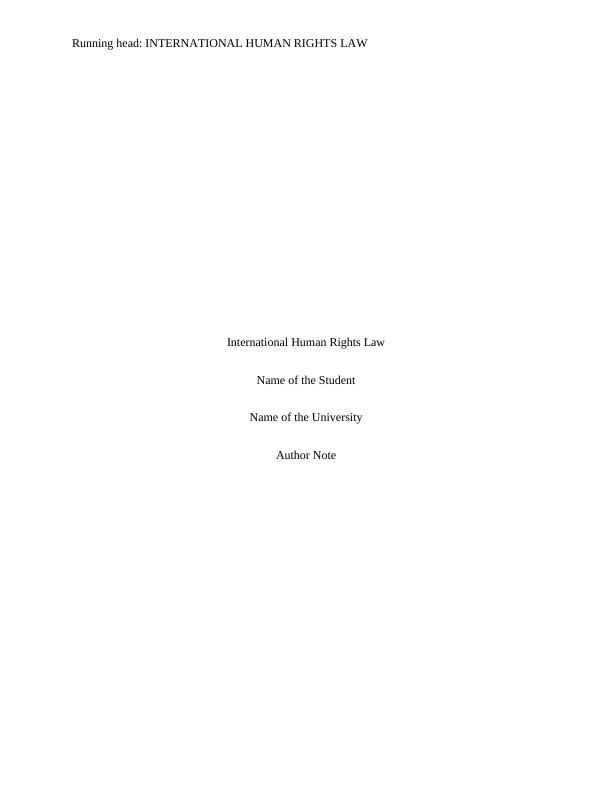
INTERNATIONAL HUMAN RIGHTS LAW1
Table of Contents
Chapter 1 – Introduction..................................................................................................................3
1.1. Background to the Research Topic...................................................................................3
1.2. Research Gaps/Problem Statement...................................................................................6
1.3. Research Aims and Objectives.........................................................................................7
1.4. Research Questions...........................................................................................................7
1.5. Research Hypothesis.........................................................................................................8
Chapter 2........................................................................................................................................13
2.1. Review of Literature...........................................................................................................13
2.1.1. Effectiveness of European Union in Promoting Human Rights......................................13
2.2. Understanding the Relationship between Globalization and Protection of Human Rights14
2.3. Exploitation of Human Rights by International Courts and Tribunals...............................15
2.4. Need for Defining Human Rights under Democratic Systems of Governance..................16
2.5. Understanding the Relationship between Human Rights and Corporate Social
Responsibility............................................................................................................................16
2.6. Challenges to International Law.........................................................................................17
2.7. Universalism and Challenges to International Law on Human Rights in Russia and the
European Union.........................................................................................................................18
2.8. Protecting the Rights of Forced Migrants under International Human Rights Law...........19
2.9. Challenges posed to International Refugee Law................................................................20
Table of Contents
Chapter 1 – Introduction..................................................................................................................3
1.1. Background to the Research Topic...................................................................................3
1.2. Research Gaps/Problem Statement...................................................................................6
1.3. Research Aims and Objectives.........................................................................................7
1.4. Research Questions...........................................................................................................7
1.5. Research Hypothesis.........................................................................................................8
Chapter 2........................................................................................................................................13
2.1. Review of Literature...........................................................................................................13
2.1.1. Effectiveness of European Union in Promoting Human Rights......................................13
2.2. Understanding the Relationship between Globalization and Protection of Human Rights14
2.3. Exploitation of Human Rights by International Courts and Tribunals...............................15
2.4. Need for Defining Human Rights under Democratic Systems of Governance..................16
2.5. Understanding the Relationship between Human Rights and Corporate Social
Responsibility............................................................................................................................16
2.6. Challenges to International Law.........................................................................................17
2.7. Universalism and Challenges to International Law on Human Rights in Russia and the
European Union.........................................................................................................................18
2.8. Protecting the Rights of Forced Migrants under International Human Rights Law...........19
2.9. Challenges posed to International Refugee Law................................................................20
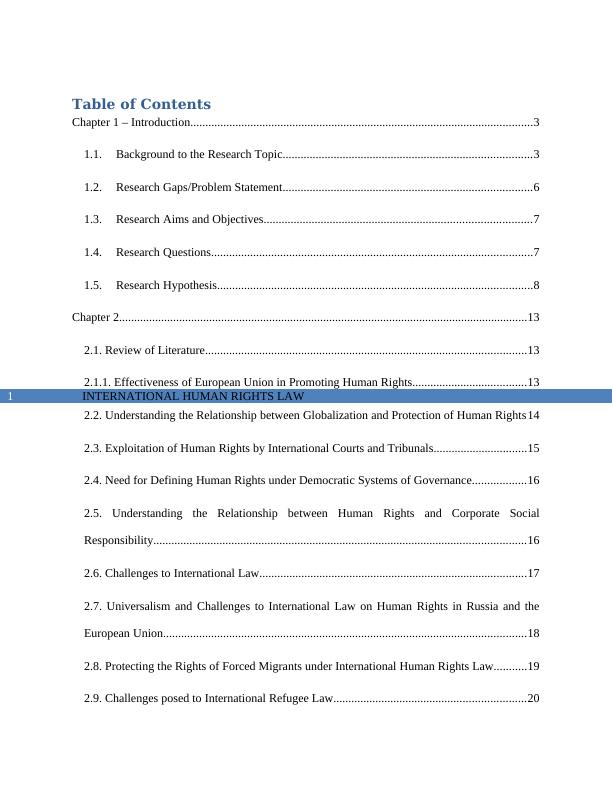
INTERNATIONAL HUMAN RIGHTS LAW2
2.10. Human Rights Protection in the Context of Business......................................................21
2.11. Gaps in the Literature Review/ Rationale for the Study...................................................21
2.3. Findings and Discussion.....................................................................................................24
2.3.1. International Laws and Conventions on the Protection of Human Rights – An Overview
...................................................................................................................................................24
2.3.2. Institutions for the Protection and Surveillance of Human Rights – An Overview........27
2.3.3. Understanding the Effectiveness of International Law on Human Rights and the Matter
of State Accountability..............................................................................................................28
Conclusion.................................................................................................................................33
References......................................................................................................................................34
2.10. Human Rights Protection in the Context of Business......................................................21
2.11. Gaps in the Literature Review/ Rationale for the Study...................................................21
2.3. Findings and Discussion.....................................................................................................24
2.3.1. International Laws and Conventions on the Protection of Human Rights – An Overview
...................................................................................................................................................24
2.3.2. Institutions for the Protection and Surveillance of Human Rights – An Overview........27
2.3.3. Understanding the Effectiveness of International Law on Human Rights and the Matter
of State Accountability..............................................................................................................28
Conclusion.................................................................................................................................33
References......................................................................................................................................34
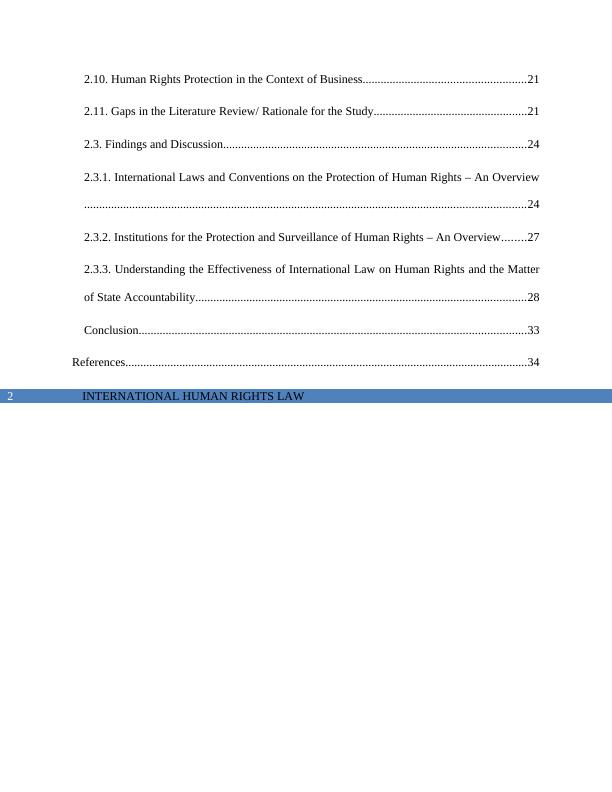
INTERNATIONAL HUMAN RIGHTS LAW3
Chapter 1 – Introduction
1.1. Background to the Research Topic
International law on human rights refers to the legal instruments that are aimed at
promoting as well as protecting human rights at both the domestic and the international levels. It
is composed primarily of what may be termed as treaty law, that is, agreements of a legally
binding nature that are drawn up between state parties, and which are based on the principle of
customary international law.1 Customary international law refers to the legal rules and
regulations that have been derived from state practices especially practices of a consistent nature.
Although customary law and treaty law are seen to form the main basis of any international law
on human rights, various other types of legal instruments such as principles, guiding principles,
guidelines and declarations that have been adopted at the international level make a contribution
to the implementation, development as well as general understanding of human rights law. 2
In the view of Greenwood (2018), when it comes to the implementation of international
law on human rights, it needs to be remembered first and foremost, that enforcement is
something that can take place at both the domestic and international level, depending on whether
or not the country where the law is attempting to be enforced is a country that accepts human
rights law in the first place. 3States which are seen to sign and ratify treaties on the protection of
human rights, are states that make an official commitment to protecting and upholding human
rights and to adopting the measures that are needed to avoid human rights being violated for any
citizen. According to Claire (2017), it is also the responsibility of such states to make sure of the
1 Greenwood C, 'International Law And The Use Of Force' [2018] Oxford University Press
2 Ibid
3 Ibid
Chapter 1 – Introduction
1.1. Background to the Research Topic
International law on human rights refers to the legal instruments that are aimed at
promoting as well as protecting human rights at both the domestic and the international levels. It
is composed primarily of what may be termed as treaty law, that is, agreements of a legally
binding nature that are drawn up between state parties, and which are based on the principle of
customary international law.1 Customary international law refers to the legal rules and
regulations that have been derived from state practices especially practices of a consistent nature.
Although customary law and treaty law are seen to form the main basis of any international law
on human rights, various other types of legal instruments such as principles, guiding principles,
guidelines and declarations that have been adopted at the international level make a contribution
to the implementation, development as well as general understanding of human rights law. 2
In the view of Greenwood (2018), when it comes to the implementation of international
law on human rights, it needs to be remembered first and foremost, that enforcement is
something that can take place at both the domestic and international level, depending on whether
or not the country where the law is attempting to be enforced is a country that accepts human
rights law in the first place. 3States which are seen to sign and ratify treaties on the protection of
human rights, are states that make an official commitment to protecting and upholding human
rights and to adopting the measures that are needed to avoid human rights being violated for any
citizen. According to Claire (2017), it is also the responsibility of such states to make sure of the
1 Greenwood C, 'International Law And The Use Of Force' [2018] Oxford University Press
2 Ibid
3 Ibid
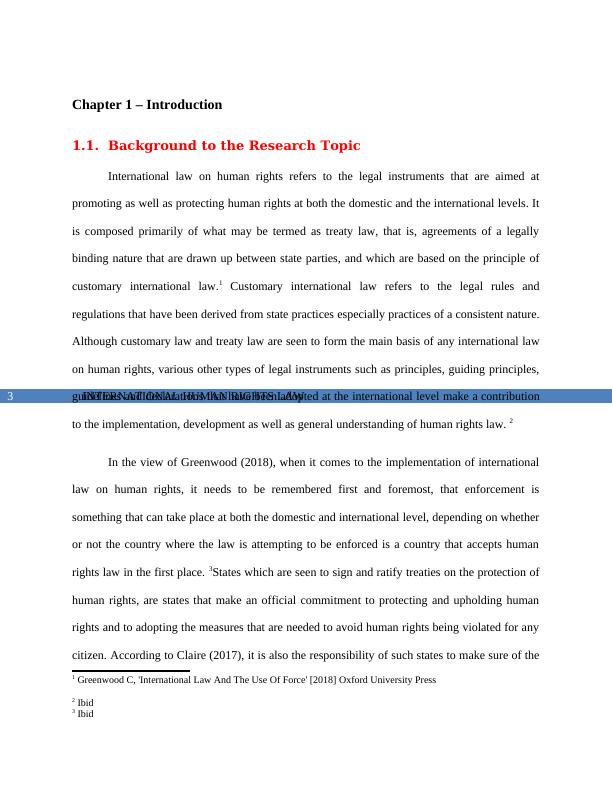
INTERNATIONAL HUMAN RIGHTS LAW4
fact that their domestic laws are those that are compatible or in keeping with international
standards of human rights. In the event that domestic law or the law of the land is not successful
in preserving and protecting human rights, it is possible for the injured parties to take recourse to
international laws on human rights in order to seek and acquire justice for the wrongs that have
been done to them. 4
As per the view of Gibson (2017), although international law on human rights is
something that bears a lot of resemblance to international humanitarian law, it is important to
remember that an important distinction exists between both types of law. Both laws are seen to
complement one another largely because of the fact the substantive norms which are contained in
such laws are related or similar to one another. For Hathaway (2018), the international
humanitarian legal regime is also one which is seen to apply exclusively to situations of armed
conflict, including the concept and occurrence of occupation, when both of the legal regimes are
made to apply in tandem with one another. 5
According to Hathaway (2018), international human rights law in the modern day and
age can be said to have come into existence with the drafting of what may be termed as the
Universal Declaration of Human Rights in the year of 1948. This is a non-binding legal
agreement that was drafted initially as a standard common for the achievement of humanitarian
goals and objectives and as such it spells out all the economic, civil, social as well as cultural
rights which human beings all over the world need to be given access to.6 The Universal
4 Claire M, 'The Emerging Norm Of Corporate Social Responsibility. In Human Rights And Corporations' [2017]
Routledge
5 Gibson KA Syrnington, 'Business And Human Rights: Current And Future Challenges'
6 Hathaway J, 'Special Feature: Eighth Colloquium On Challenges In International Refugee Law' (2018) 39
Michigan Journal of International Law
fact that their domestic laws are those that are compatible or in keeping with international
standards of human rights. In the event that domestic law or the law of the land is not successful
in preserving and protecting human rights, it is possible for the injured parties to take recourse to
international laws on human rights in order to seek and acquire justice for the wrongs that have
been done to them. 4
As per the view of Gibson (2017), although international law on human rights is
something that bears a lot of resemblance to international humanitarian law, it is important to
remember that an important distinction exists between both types of law. Both laws are seen to
complement one another largely because of the fact the substantive norms which are contained in
such laws are related or similar to one another. For Hathaway (2018), the international
humanitarian legal regime is also one which is seen to apply exclusively to situations of armed
conflict, including the concept and occurrence of occupation, when both of the legal regimes are
made to apply in tandem with one another. 5
According to Hathaway (2018), international human rights law in the modern day and
age can be said to have come into existence with the drafting of what may be termed as the
Universal Declaration of Human Rights in the year of 1948. This is a non-binding legal
agreement that was drafted initially as a standard common for the achievement of humanitarian
goals and objectives and as such it spells out all the economic, civil, social as well as cultural
rights which human beings all over the world need to be given access to.6 The Universal
4 Claire M, 'The Emerging Norm Of Corporate Social Responsibility. In Human Rights And Corporations' [2017]
Routledge
5 Gibson KA Syrnington, 'Business And Human Rights: Current And Future Challenges'
6 Hathaway J, 'Special Feature: Eighth Colloquium On Challenges In International Refugee Law' (2018) 39
Michigan Journal of International Law

INTERNATIONAL HUMAN RIGHTS LAW5
Declaration of Human Rights of 1948 is also an instrument that is accepted worldwide as one
which outlines the fundamental human rights norms which ought to be expected and respected in
each and every country of the world, with no exception being made in this respect. Together with
the International Covenant on Economic, Social and Cultural Rights and the International
Covenant on Civil and Political Rights, the Universal Declaration of Human rights forms what
may be termed as the International Human Rights Bill, a legal instrument that must be adhered to
by all countries of the world that believe in and profess to protect human rights and human
dignity rather than perpetrating its violation and abuse.7
As stated by Gready (2019), a number of international treaties and agreements on the
subject of human rights have been adopted ever since the year of 1945, all of which confer some
sort of legal form or basis on human rights of an inherent nature, and which have made a
contribution to human rights as a body being developed and expanded by a considerable extent8.
Some examples of such human rights treaties and agreements are Convention relating to the
Status of Refugees of 1951, Convention on Prevention and Punishment of the Crime of
Genocide, Convention on Elimination of All Forms of Discrimination against Women,
Conventional on Elimination of All Forms of Racial Discrimination, UN Convention on the
Rights of the Child, UN Convention on Torture, UN Convention on the Rights of People with
Disabilities, Convention on Protection of All Persons from Enforced Disappearance, and
Convention on the Protection of Rights of all Migrant Workers and Members of their
Families.9
7 Ibid
8 Paul Gready, 'Reflections On A Human Rights Decade: Near And Far' (2019) 11 Journal of Human Rights
Practice.
9 Greenwood C, 'International Law And The Use Of Force' [2018] Oxford University Press
Declaration of Human Rights of 1948 is also an instrument that is accepted worldwide as one
which outlines the fundamental human rights norms which ought to be expected and respected in
each and every country of the world, with no exception being made in this respect. Together with
the International Covenant on Economic, Social and Cultural Rights and the International
Covenant on Civil and Political Rights, the Universal Declaration of Human rights forms what
may be termed as the International Human Rights Bill, a legal instrument that must be adhered to
by all countries of the world that believe in and profess to protect human rights and human
dignity rather than perpetrating its violation and abuse.7
As stated by Gready (2019), a number of international treaties and agreements on the
subject of human rights have been adopted ever since the year of 1945, all of which confer some
sort of legal form or basis on human rights of an inherent nature, and which have made a
contribution to human rights as a body being developed and expanded by a considerable extent8.
Some examples of such human rights treaties and agreements are Convention relating to the
Status of Refugees of 1951, Convention on Prevention and Punishment of the Crime of
Genocide, Convention on Elimination of All Forms of Discrimination against Women,
Conventional on Elimination of All Forms of Racial Discrimination, UN Convention on the
Rights of the Child, UN Convention on Torture, UN Convention on the Rights of People with
Disabilities, Convention on Protection of All Persons from Enforced Disappearance, and
Convention on the Protection of Rights of all Migrant Workers and Members of their
Families.9
7 Ibid
8 Paul Gready, 'Reflections On A Human Rights Decade: Near And Far' (2019) 11 Journal of Human Rights
Practice.
9 Greenwood C, 'International Law And The Use Of Force' [2018] Oxford University Press
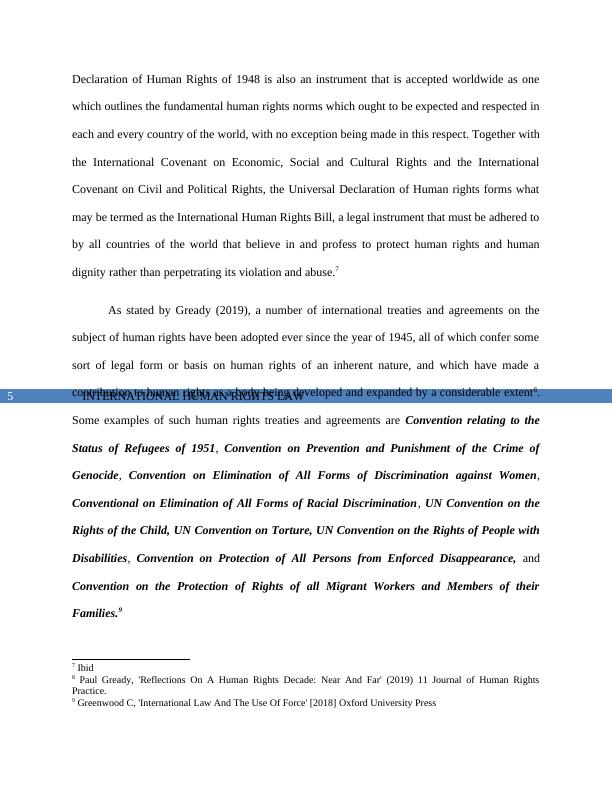
INTERNATIONAL HUMAN RIGHTS LAW6
One of the most important roles of international law on human rights is that it prescribes
all the obligations that are bound to be respected by states. As stated by Greenwood (2018), by
ratifying an international treaty on human rights, it is expected that is expected that the state will
introduce domestic legislation or domestic measures that are compatible with all the obligations
that have been laid out in this treaty. 10For Hathaway (2018), when ratifying an international
treaty, a state assumes duties and obligations under the purview of international law that are
meant for the protection, preservation and fulfillment of human rights standards. States, in other
words, are placed under the obligation of preventing human rights violations and protecting
human dignity and human rights in their sovereign territory, and must refrain as such from
curtailing or interfering in the process of enjoyment of human rights by the people of the
country. It is under obligation to protection groups of people as well as individuals from the
abuse of human rights and has to undertake the positive course of action that is necessary for
making sure that basic human rights are enjoyed and respected by people of the country. 11
Gready (2019), states that there are of course a number of monitoring mechanisms that
are in place to make sure of the fact that human rights treaties or instruments as signed and
ratified by states are those that are being complied with. These are monitoring mechanisms or
bodies that have been created by the United Nations Organization and which are comprised of
what may be termed as independent experts for the most part. Secretariat support is received and
enjoyed by most of these bodies from the Office of the High Commissioner of Human Rights. It
may also be pointed out in this respect that similar mechanisms are not seen to exist for ensuring
the adequate protection and implementation of international humanitarian law.12
10 Ibid
11 Hathaway J, 'Special Feature: Eighth Colloquium On Challenges In International Refugee Law' (2018) 39
Michigan Journal of International Law
12 Paul Gready, 'Reflections On A Human Rights Decade: Near And Far' (2019) 11 Journal of Human Rights Practice.
One of the most important roles of international law on human rights is that it prescribes
all the obligations that are bound to be respected by states. As stated by Greenwood (2018), by
ratifying an international treaty on human rights, it is expected that is expected that the state will
introduce domestic legislation or domestic measures that are compatible with all the obligations
that have been laid out in this treaty. 10For Hathaway (2018), when ratifying an international
treaty, a state assumes duties and obligations under the purview of international law that are
meant for the protection, preservation and fulfillment of human rights standards. States, in other
words, are placed under the obligation of preventing human rights violations and protecting
human dignity and human rights in their sovereign territory, and must refrain as such from
curtailing or interfering in the process of enjoyment of human rights by the people of the
country. It is under obligation to protection groups of people as well as individuals from the
abuse of human rights and has to undertake the positive course of action that is necessary for
making sure that basic human rights are enjoyed and respected by people of the country. 11
Gready (2019), states that there are of course a number of monitoring mechanisms that
are in place to make sure of the fact that human rights treaties or instruments as signed and
ratified by states are those that are being complied with. These are monitoring mechanisms or
bodies that have been created by the United Nations Organization and which are comprised of
what may be termed as independent experts for the most part. Secretariat support is received and
enjoyed by most of these bodies from the Office of the High Commissioner of Human Rights. It
may also be pointed out in this respect that similar mechanisms are not seen to exist for ensuring
the adequate protection and implementation of international humanitarian law.12
10 Ibid
11 Hathaway J, 'Special Feature: Eighth Colloquium On Challenges In International Refugee Law' (2018) 39
Michigan Journal of International Law
12 Paul Gready, 'Reflections On A Human Rights Decade: Near And Far' (2019) 11 Journal of Human Rights Practice.
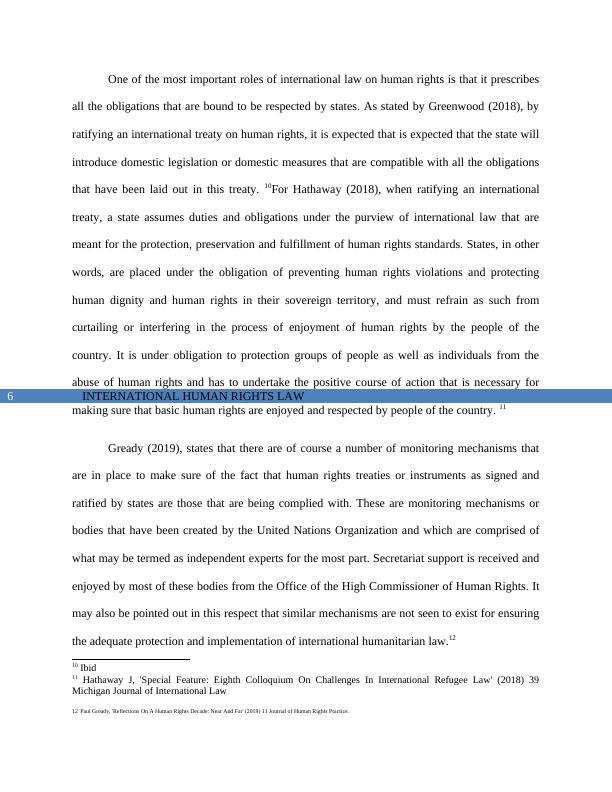
INTERNATIONAL HUMAN RIGHTS LAW7
1.2. Research Gaps/Problem Statement
A decent body of literature is seen to exist on international legal instruments for the
protection of human rights, as well as the international human rights standards that countries
around the world are expected to follow or to adhere to in order to ensure human rights is
something that is protected and respected on their individual territories. The literature clearly
establishes that governments around the world must take cognizance of international human
rights law and standards. Yet little information exists on how successful international treaties and
agreements can be in upholding and protecting human rights. This research aims to investigate
and provide an understanding of how international law has come to the aid of persons whose
human rights have been violated, assessing in the process the effectiveness of international law
in human rights in this respect.
1.3. Research Aims and Objectives
Some of the important aims and objectives of this research study are as follows –
To arrive at an understanding of the various treaties and agreements that exist on the
protection of human rights
To determine the role of human rights organizations and bodies that have been created by
the UN for ensuring adequate protection of human rights
To assess the effectiveness of international treaties on human rights in protecting and
upholding human rights.
To understand the ways and means by which states can be made more accountable in
protecting and upholding international treaties on human rights.
1.2. Research Gaps/Problem Statement
A decent body of literature is seen to exist on international legal instruments for the
protection of human rights, as well as the international human rights standards that countries
around the world are expected to follow or to adhere to in order to ensure human rights is
something that is protected and respected on their individual territories. The literature clearly
establishes that governments around the world must take cognizance of international human
rights law and standards. Yet little information exists on how successful international treaties and
agreements can be in upholding and protecting human rights. This research aims to investigate
and provide an understanding of how international law has come to the aid of persons whose
human rights have been violated, assessing in the process the effectiveness of international law
in human rights in this respect.
1.3. Research Aims and Objectives
Some of the important aims and objectives of this research study are as follows –
To arrive at an understanding of the various treaties and agreements that exist on the
protection of human rights
To determine the role of human rights organizations and bodies that have been created by
the UN for ensuring adequate protection of human rights
To assess the effectiveness of international treaties on human rights in protecting and
upholding human rights.
To understand the ways and means by which states can be made more accountable in
protecting and upholding international treaties on human rights.
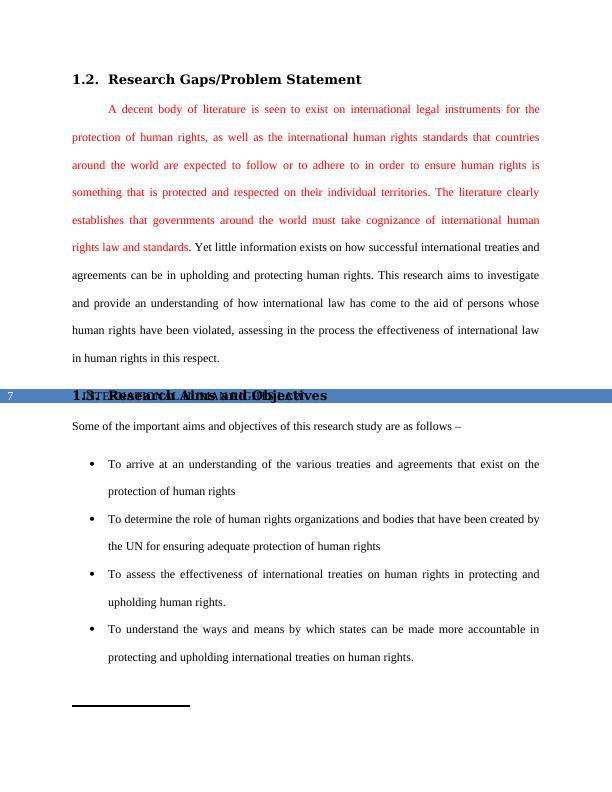
End of preview
Want to access all the pages? Upload your documents or become a member.
Related Documents
Evaluation of the Methods to Measure the Effectiveness of EU Lawlg...
|9
|1812
|265
Human Rights Violation over the Children Refugees in the Host Countrylg...
|66
|18685
|424
International Rule of Law and constitutional justice PDFlg...
|24
|8989
|77
Establishing the European Economic Communitylg...
|15
|4141
|20
Provisional Application of ECT in Yukos Caselg...
|24
|9766
|431
Chapter 2 : The Judiciary and The Environmentlg...
|51
|19639
|35
